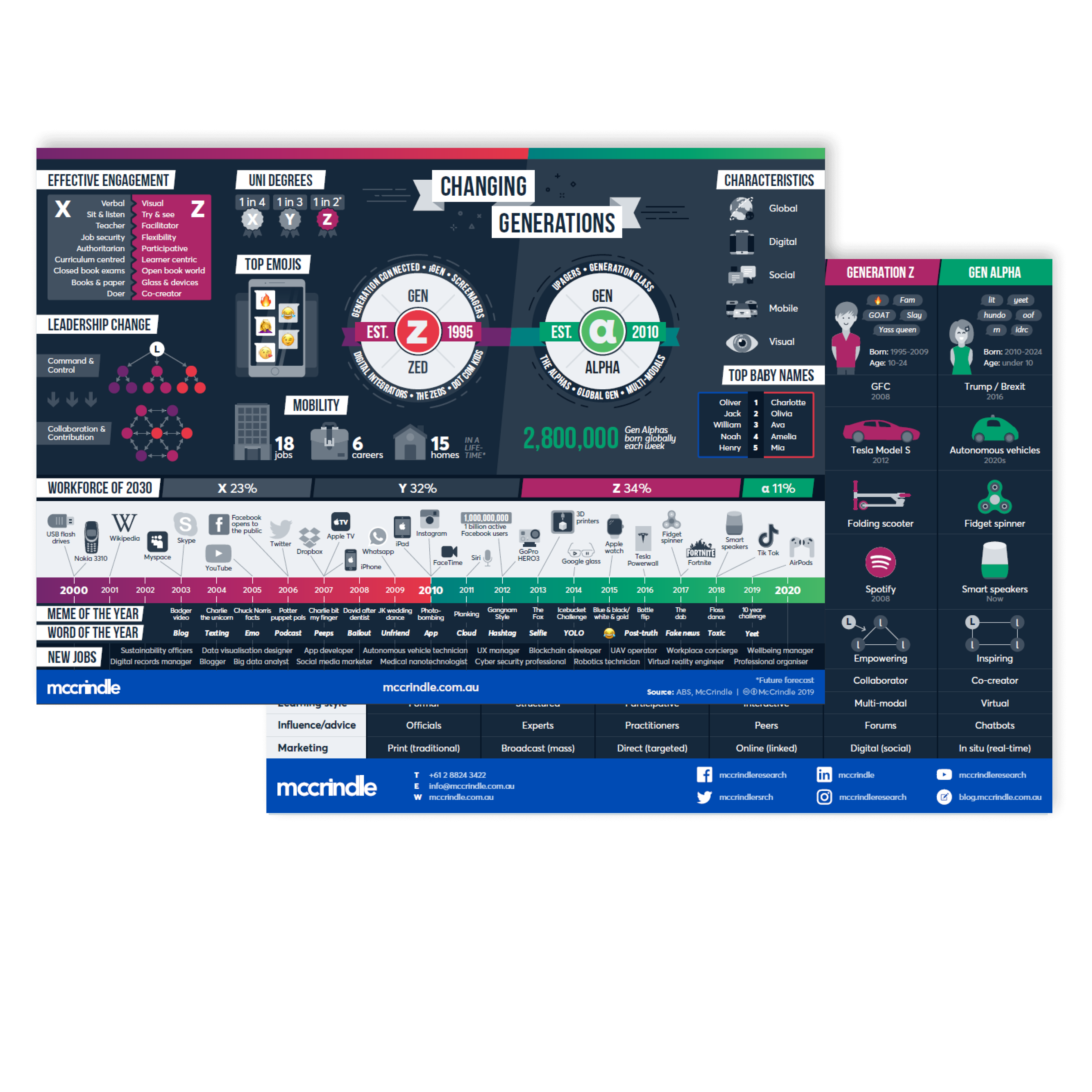Generation Z Commence University: Choosing the Right Course

2.1 million Australians (9% of the total population) are enrolled in formal study beyond the school classroom and 7.8 million Australians aged 25-64 have a post-secondary qualification which is 2 in 3 people (67%, up from 54% a decade ago).
2014 marks the first year of Generation Z, those born since 1995, entering university. They are the most digitally supplied, globally connected, and formally educated generation in history. They not only have more institutions to consider – from traditional universities to private colleges, but more ways to study – from on-campus to online, and more course options than ever before.
As these Gen Zs begin their university studies and many of Australia’s Gen Ys seek to further their current qualifications, McCrindle Research analyses ABS and Graduate Careers Australia data to compile lists of the best degrees.
Graduate earnings hit an all-time low in real terms
Three decades ago, the average graduate’s starting salary was the same as average full-time weekly earnings (average male full-time earnings). Therefore, when the Baby Boomers graduates were commencing their employment, the average 21 year-old bachelor-level graduates began their earning years on a salary equivalent the average full-time earner.
Graduate starting salaries have continued to lose ground against average weekly earnings and are now just over 77% of this benchmark.
Additionally, the variation in starting salaries across courses is massive, ranging from more than $64,000 (engineering) to $39,000 (pharmacy), while the average starting salary for a construction worker is $40,000 and for a factory worker is $42,000.
But degrees offer good earnings growth
The difference in starting salaries between those who enter the workforce without tertiary qualifications and those with a bachelor degree is negligible, but the motivating factor to pursue higher education remains. A senior salary for a factory worker is $63,000, for a construction worker it is $75,000, for a pharmacist it is $80,500, and for an engineer, $173,000.
Generation debt
There are more graduates than ever and at the same time more study debt than ever. The average HELP/HECS debt has increased from $10,600 in 2006 to $15,200 in 2012. There are currently almost 1.7 million Australians with a HECS debt, and the most common HECS debt owed (by more than a quarter of million HECS-debtors) is between $20,000 and $30,000. The total study debt owed to the Commonwealth is approach $30 billion, with most of this owed by Generation Y. It is estimated that up to 20% of this will never be repaid.
Generation Z will run up more study debt than any other generation in history. The challenge, as this analysis reveals, is that the majority of graduates in some of these course areas will accumulate a significant debt for a degree in a field in which they will never work. The mixed blessing for graduates in some of these courses is that they will not have to pay off their study debt for some time as the average starting salary is well below the current HECS-HELP repayment threshold of $51,309.
More graduates, less work
For the Builders generation (those aged in their late 60s), just 1 in 10 have a university degree. For the Baby Boomers (those in their 50s) this is 1 in 5, for Generation X (those in their 30s) it is 1 in 4, and for today’s Generation Ys (in their late 20s) 1 in 3 hold a tertiary qualification. Based on current trends for today’s school aged students, Generation Z, as many as 1 in 2 will likely end up with a university degree.
Yet while the proportions of Australians with university degrees continue to rise, the number of bachelor degree graduates who are able to secure work within 4 months of graduating is significantly decreasing, with 71% of bachelor-degree graduates able to secure full-time employment in 2013 compared to 76.1% in 2012 and 76.3% in 2011.
At the same time, the percentage of graduates in part-time or casual employment and looking for full-time work is increasing (18.1% in 2013 compared to 15.3% in 2012 and 14.9% in 2011), as is the percentage of students not working but looking for full-time employment (10.6% in 2013 up from 8.6% in 2012 and 8.7% in 2011).
Emerging careers
In order for today’s school leavers to combat the unprecedented choices they have in studying, they need to look to Australia’s economic, demographic, and technology future to make informed choices. Many Australians are employed in jobs today that didn’t exist a decade ago, and of the estimated 17 jobs that Gen Z will hold in their lifetime, some of these don’t currently exist.
In McCrindle Research’s national study, when Australians were asked to nominate which courses of study they felt will emerge over the next decade to accommodate growth areas and emerging careers, respondents focused predominantly on the digital age and health care.
Careers in information technology, computing science, digital media, online education, digital communication, and any other skills requiring computer technologies were seen to be on the rise, as were careers focusing on health and medicine, particularly in the provision of aged care health services. Australians also felt that the field of environmental science and research into renewable energies and resources would continue to increase in the decade ahead.
Top 4 ‘Future-Proofed’ Degrees
These degrees are often underrated and overlooked, yet turn out to offer the best graduate employment opportunities. More than 4 in 5 (80%) graduates from bachelor level study were available for full-time employment, and the vast majority of these were working in their field of study. Additionally, each of these top four courses delivered a salary above the national $50,000 graduate average.
|
Rank |
Name of Course |
Available for Full-time employment |
Of those in full-time employment, % working in their field of study |
Median starting salary |
|
1. |
Surveying |
85% |
90% |
$52,000 |
|
2. |
Urban/Regional Planning |
81% |
81% |
$50,000 |
|
3. |
Rehabilitation |
80% |
89% |
$50,200 |
|
4. |
Electrical Engineering |
80% |
76% |
$60,000 |
Table 1: ‘Future-Proofed’ Degrees
Social researcher Mark McCrindle comments on Australia’s most underrated degrees, stating: “Australia’s population growth is creating the need for more homes than ever and the redevelopment of many existing urban centres. This planning and construction boom is creating great opportunities for graduates in relevant fields and has facilitated surveying, urban planning, and engineering to be rated in the Top 4 courses based on a combination of employment, earnings and analysis”.
“Additionally,” McCrindle says, “Australia’s ageing population is creating growth and opportunities in courses in the rehabilitation and health fields”.
Top 4 ‘Populist’ Degrees
These Top 4 “Populist” Degrees are those that are impacted by their own success. When the supply of undergraduates exceeds the demand on the employment side, many graduates end up either moving to further study rather than employment, working in a career in a different field to their course or commencing on salaries below the average graduate starting salary.
One of the most popular university subjects is Psychology (currently ranked 6th most popular in the world by Topuniversities.com) and in Australia it is also one of the most popular courses. The data below shows that only 40% of Psychology graduates are “career-ready” (available for full-time employment), and of graduates who are currently in full-time employment, only 63% are working in the field of psychology. In addition, those who are working full-time in their field start off with a median salary of $47,500, well below the average starting salary of $50,000.
Of all visual and performing arts graduates, just half of those employed are working in their field of study, and architecture offered one of the lowest graduate starting salaries.
Based on the above criteria (the percentage of graduates available for full-time employment, their employability in their field of study, and their median salary), here are the degrees which most fit this criteria:
|
Rank |
Name of Course |
Available for Full-time employment |
Of those in full-time employment, % working in their field of study |
Median starting salary |
|
1. |
Psychology |
40% |
63% |
$47,500 |
|
2. |
Architecture |
42% |
72% |
$32,500 |
|
3. |
Visual and Performing Arts |
47% |
52% |
$38,000 |
|
4. |
Social Sciences |
49% |
60% |
$45,000 |
Table 2: Most ‘Populist’ Degrees
“Along with arts, law, and the social sciences, psychology has become a ‘generalist’ degree rather than an avenue to professional practice and the figures need to be seen in this light,” says Mark McCrindle.
“As a psychology graduate not working as a psychologist, I can understand the interest in the field and despite the statistics above, I know first-hand its benefits as a foundational degree,” he states.
Click here to download this social analysis:
Sources: McCrindle Research, Graduate Careers Australia, ABS Measures of Australia’s Progress, DEEWR Higher Education Reports, DIISRTE, Open Universities Australia.






